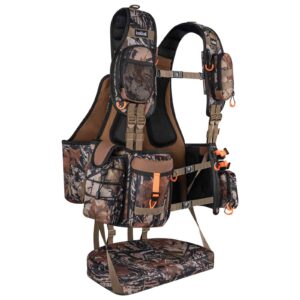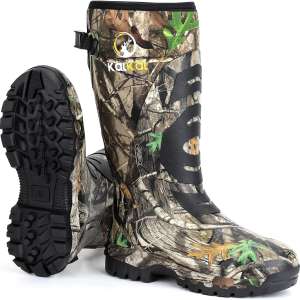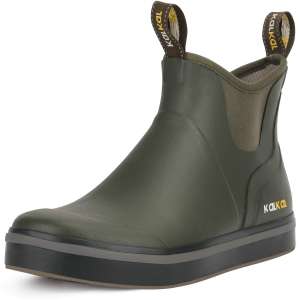Have you ever tried hiking with steel toe boots?
The idea of wearing steel toe boots feels sluggish. Especially when you’ve never worn them before. But here’s the thing. It’s a mixture of worryful feeling and excitement. You are intrigued by the challenging trails and wish to explore the depth of wilderness—but will your sneakers withstand the trek? You’ll instantly regret your decision not to go hiking with steel toe boots because your first impression of these boots is that they are not comfy and indeed, not cool. Am I right?
Let’s explore should you hiking with steel toe boots. And, also we guide you to finding the perfect pair for your adventure to toe the line of safety. So, tie up your bootlaces and hit the trails!
Can You Hiking With Steel Toe Boots?
Wearing steel toe boots and walking on a tightrope is similar in some cases. I often find steel toes in hiking boots. Many people use steel toes in their day-to-day routine, including hiking and backpacking.
Here you have the pros and cons to choose the best for you.
Pros of Hiking with steel toe boots
- Durability: Steel toe boots have hype for their durability and these boots are ideal for outdoor activities where you encounter sharp objects.
- Stability: steel toes provide stability for hikers to feel more secure on uneven terrain.
- Protection: if you are hiking with steel toe boots, you shouldn’t worry about getting your toes crushed by heavy objects or hazardous environments.
Cons of Hiking with steel toe boots
- Weight: hiking with steel toe boots is generally a challenge because of their heavier formation, which can make them uncomfortable for long hikes and rough terrain.
- Comfort: Steel toes are not as comfy as other hiking boots, such as coldness in winter and discomfort on rough terrain.
- Cost: steel toes can be a burden on your pocket. So, think before opting.
When planning a long trek or hiking on hard terrain, choose cautiously; lighter and more comfortable hiking footwear should be considered. Steel toe boots may be a good option for extra protection and durability.
What Are Steel Toe Boots For?
This subject sparked a debate, with some arguing that steel toe boots provide safety, particularly in difficult terrain, while others express worries about comfort and flexibility.
Steel toe boots feature a reinforced toe cap made of steel, and are mainly designed for hazardous working environments, which prevent foot injury from sharp objects and impacts. When it comes to hiking, the tough design of these boots protects against strange things.
However, the weight and restricted flexibility may present difficulties on lengthy or uneven hikes. Before purchasing steel toe boots, consider your particular comfort preferences as well as the unique demands of your selected terrain.
What Will Happen If You Hiking In Steel Toe Boots?
In some scenarios, some people believe that steel toe hiking boots are safer than normal hiking boots. The steel toe cap provides additional protection to the front of the boot.
These boots are very useful for people who work in construction or industrial environments that need to be guarded against hazardous substances.
While some steel toes are heavier and not specifically designed for long-distance walking, the sole isn’t likely suitable. Your feet will be sore after a long hike.
If you do want to wear safety boots for hiking, go for those composite toe boots. They are lighter than steel toes.
What Are The Best Footwear for Hiking?
Hiking boots should give ankle support, grip, durability, and foot comfort during the trek, according to what constitutes a great hiking shoe. Look for waterproof footwear.
There are various variables to consider while selecting the best hiking footwear. Different types of boots are appropriate for other hiking circumstances and preferences. Here are some of the most common varieties of hiking boots and their characteristics:
- Hiking Shoes: Low-cut versions with flexible midsoles and light weight are ideal for day hiking.
- Day Hiking Boots: These are mid-to-high-cut styles designed for short day hikes. They are adaptable, but only on occasion.
- Backpacking Boots: These boots have a high cut that wraps above the ankles for good support and are designed to carry heavy loads.
- Synthetic/Leather Boots: For many years, these boots have been one of the most popular choices in hiking footwear. They provide a good blend of comfort, weight, and durability.
- Hiking Boots with Gore-Tex Liners: These boots provide waterproof protection and are ideal for damp or rainy trips. During extended hikes, the Gore-Tex liner keeps feet dry and comfortable.
When choosing hiking boots, you must consider the hiking you plan to do. Try on different types of hiking boots to find the one that best suits your needs and preferences.
What Features Should Hiking Boots Have?
Hiking boots are the essential choice for planning to go on the trail. Here are some key features that hiking boots should have, based on the information from the search results:
- Support and Stability
Hiking boots should provide excellent support and stability, especially for backpacking and rough terrain. Look for boots with a high cut that wraps above the ankles for superior support.
- Waterproofing
Waterproof boots are the most popular choice by far, as they provide protection from water and keep your feet dry and comfortable. Gore-Tex liners are a common feature in waterproof hiking boots.
- Durability
Hiking boots should withstand wear and tear from rugged terrain. Full-grain leather is always excellent and durable for abrasion resistance.
- Comfort
Good hiking boots need to be comfortable for most people. Look for boots that provide a rich mix of support, stability, and traction at a reasonable price point.
- Weight
The trend is toward lighter materials that still offer decent support. Lightweight boots are suitable for day hiking and fast packing, offering a balance between protection and comfort.
- Breathability
Breathable fabrics are essential to prevent your feet from getting too hot and sweaty. Look for boots with breathable uppers and linings to keep your feet comfortable.
- Traction
Hiking boots should provide solid traction to prevent slips and falls on various terrains. High-quality outsoles with deep lugs offer excellent traction.
The Best Hiking Boots Recommendations
Here you have some of the best hiking boots recommended for your next trip in 2024.
Salomon X Ultra 4 Mid GTX
- Features: Polyurethane-coated leather and textile upper, durable and comfortable
- Pros: Highly rated by users, comfortable out of the box, and suitable for various hiking conditions
- Cons: Heavier than some other options
Merrell Moab 3 Mid WP
- Features: Lightweight, waterproof, and suitable for day hiking and lightweight backpacking
- Pros: Comfortable, good value for the price, and versatile
- Cons: Some users find the soles less durable for long-term use
Lowa Renegade GTX Mid
- Features: Nubuck leather upper, durable and supportive, with a Gore-Tex liner for waterproof protection
- Pros: Comfortable, no blisters reported, and fits like a glove
- Cons: Heavy (2 lbs. 2 oz. for women’s and 2 lbs. 7 oz. for men’s)
Danner Trail 2650
- Features: Leather and textile upper, comfortable and lightweight (1 lb. 2 oz. for women’s hiking boots and 1 lb. 8 oz. for men’s hiking boots)
- Pros: Comfortable, durable, and suitable for daily use
- Cons: Not specifically designed for hiking, may not offer the same level of support and protection as other hiking boots
These boots are recommended for various types of hiking, including day hiking, backpacking, mountain trips, lightweight hiking, and fast-moving hikes. Their waterproof protection, durability, support, and comfort depend on the specific needs of the hiker.
When choosing the best hiking boots, it’s essential to consider factors such as the hiking you plan to do, the specific conditions of the hike, your personal preferences for comfort, protection, and weight, and the durability of the boots. Try on different types of hiking boots to find the one that best suits your needs and preferences.
When choosing the best shoes for hiking, consider the following factors:
- What type of hiking do you plan to do (backpacking, mountain trips, day hikes, etc.)?
- The specific conditions of the walk (trail difficulty, weather, and terrain)
- Your personal preferences for comfort, protection, and weight
- The durability of the shoes and their ability to withstand wear and tear
It’s essential to try on different types of hiking boots and shoes to find the one that best suits your needs and preferences. Hiking stores like REI offer a wide range of options and expert recommendations to help you make an informed decision.
In Conclusion
Choosing footwear for hiking is a personal decision influenced by various factors. While steel toe boots offer robust protection, their suitability for hiking depends on individual comfort preferences and the nature of the trail.
Exploring alternatives like the recommended hiking boots allows hikers to find the perfect balance between comfort, support, and durability. As you embark on your next hiking adventure, carefully assess the demands of the trail and choose footwear that aligns with your unique needs and preferences. Happy Hiking!



















Leave a reply